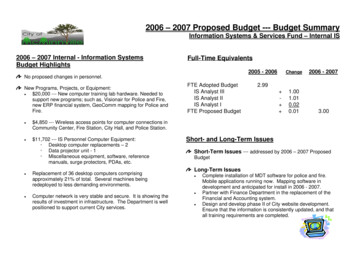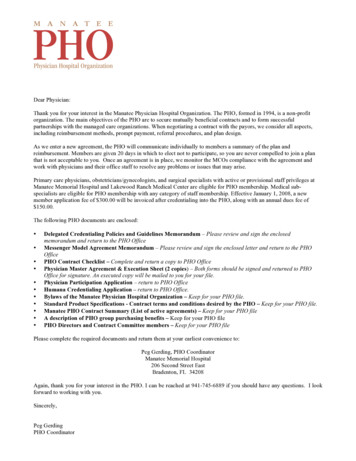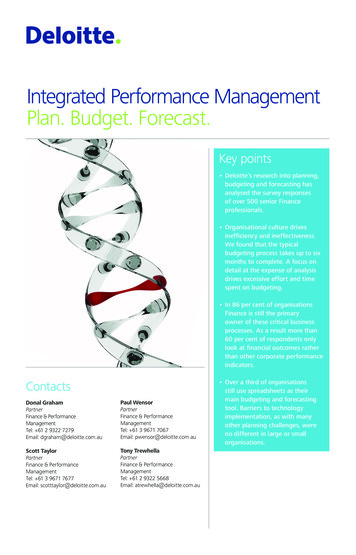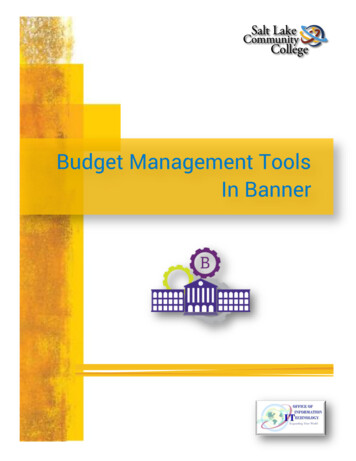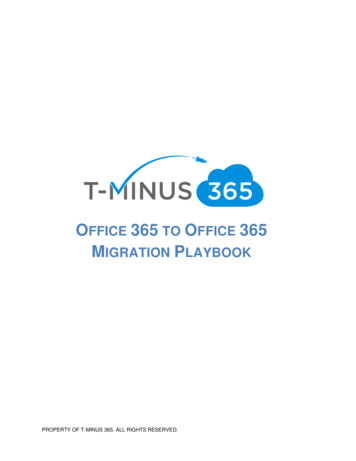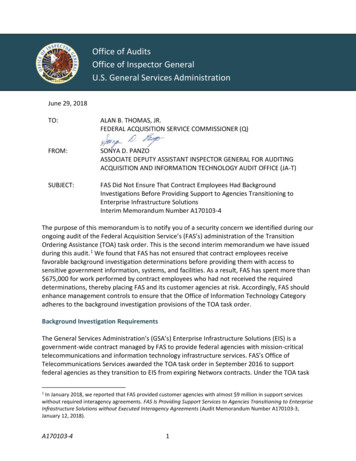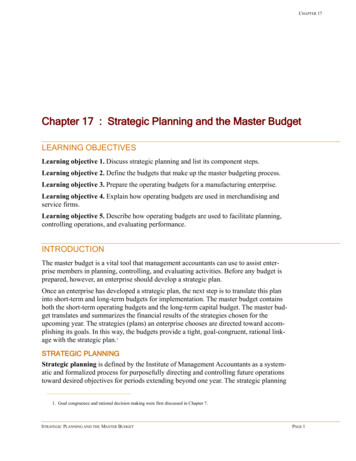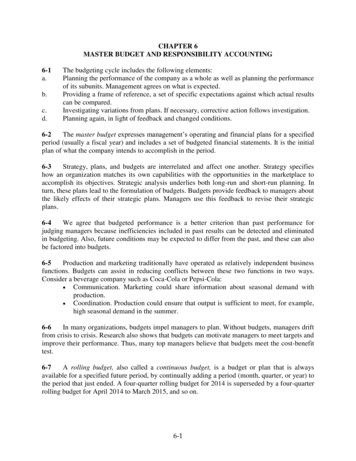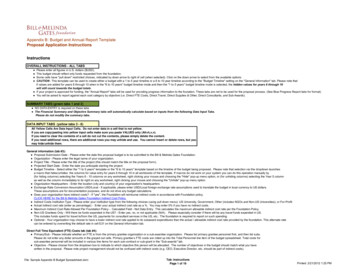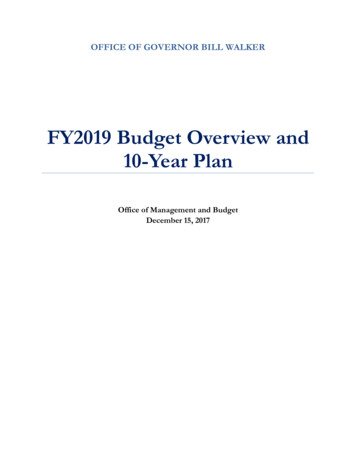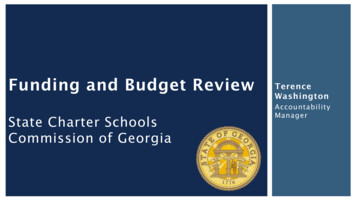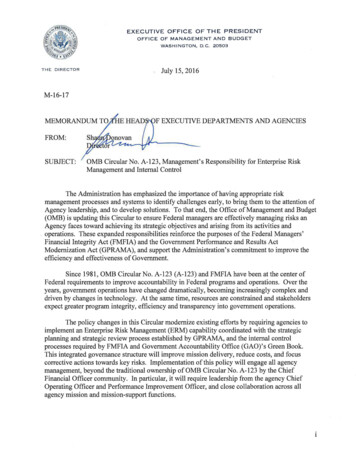
Transcription
EXECUTIVE OFFICE OF THE PRESIDENTOFFICE OF MANAGEMENT AND BUDGETWASHINGTON, D . C . 20503THE DIRECTOR. July 15, 2016M-16-17F EXECUTIVE DEPARTMENTS AND AGENCIESFROM:SUBJECT:OMB Circular No. A-123, Management's Responsibility for Enterprise RiskManagement and Internal ControlThe Administration has emphasized the importance of having appropriate riskmanagement processes and systems to identify challenges early, to bring them to the attention ofAgency leadership, and to develop solutions. To that end, the Office of Management and Budget(OMB) is updating this Circular to ensure Federal managers are effectively managing risks anAgency faces toward achieving its strategic objectives and arising from its activities andoperations. These expanded responsibilities reinforce the purposes of the Federal Managers'Financial Integrity Act (FMFIA) and the Government Performance and Results ActModernization Act (GPRAMA), and support the Administration's commitment to improve theefficiency and effectiveness of Government.Since 1981, OMB Circular No. A-123 (A-123) and FMFIA have been at the center ofFederal requirements to improve accountability in Federal programs and operations. Over theyears, government operations have changed dramatically, becoming increasingly complex anddriven by changes in technology. At the same time, resources are constrained and stakeholdersexpect greater program integrity, efficiency and transparency into government operations.The policy changes in this Circular modernize existing efforts by requiring agencies toimplement an Enterprise Risk Management (ERM) capability coordinated with the strategicplanning and strategic review process established by GPRAMA, and the internal controlprocesses required by FMFIA and Government Accountability Office (GAO)'s Green Book.This integrated governance structure will improve mission delivery, reduce costs, and focuscorrective actions towards key risks. Implementation of this policy will engage all agencymanagement, beyond the traditional ownership of OMB Circular No. A-123 by the ChiefFinancial Officer community. In particular, it will require leadership from the agency ChiefOperating Officer and Performance Improvement Officer, and close collaboration across allagency mission and mission-support functions.1
Successful implementation of this Circular requires Agencies to establish and foster anopen, transparent culture that encourages people to communicate information about potentialrisks and other concerns with their superiors without fear of retaliation or blame. Similarly,agency managers, Inspectors General (IG) and other auditors should establish a new set ofparameters encouraging the free flow of information about agency risk points and correctivemeasure adoption. An open and transparent culture results in the earlier identification of risk,allowing the opportunity to develop a collaborative response, ultimately leading to a moreresilient government.This revision of the Circular has gone through an extensive deliberative process withAgencies and their IG teams, and including consultation with the GAO and many outside groupswho seek more efficient and effective delivery of governmental services. This revised Circularis effective for Fiscal Year (FY) 2016 and supersedes all previous versions. Appendices A, B, C,and D of OMB Circular No. A-123 remain in effect. Updates to the GAO greenbook areeffective for FY 2016. ERM implementation requirements are effective for FY 2017. OMBplans to work closely with the President's Management Council, Executive Councils, and theCouncil oflnspectors General on Integrity and Efficiency (CIGIE) to provide furtherimplementation guidance.Attachment:OMB Circular No. A-123, Management's Responsibility for Enterprise Risk Management andInternal Control11
ATTACHMENTOMB Circular No. A-123, Management’s Responsibility for Enterprise Risk Managementand Internal ControlPurpose: This Circular defines management’s responsibilities for enterprise risk management(ERM) and internal control. The Circular provides updated implementation guidance to Federalmanagers to improve accountability and effectiveness of Federal programs as well as missionsupport operations through implementation of ERM practices and by establishing, maintaining,and assessing internal control effectiveness. The Circular emphasizes the need to integrate andcoordinate risk management and strong and effective internal control into existing businessactivities and as an integral part of managing an Agency.Authority: This Circular is issued under the authority of the Federal Managers' FinancialIntegrity Act (FMFIA) of 1982 as codified in 31 U.S.C. 3512, and the Government PerformanceResults Act (GPRA) Modernization Act, Public Law 111-352.Policy: Each Federal employee is responsible for safeguarding Federal assets and the efficientdelivery of services to the public. Federal leaders and managers are responsible for establishinggoals and objectives around operating environments, ensuring compliance with relevant laws andregulations, and managing both expected and unexpected or unanticipated events. They areresponsible for implementing management practices that identify, assess, respond, and report onrisks. Risk management practices must be forward-looking and designed to help leaders makebetter decisions, alleviate threats and to identify previously unknown opportunities to improvethe efficiency and effectiveness of government operations. Management is also responsible forestablishing and maintaining internal controls to achieve specific internal control objectivesrelated to operations, reporting, and compliance. Management must consistently apply theseinternal control standards to meet the internal control principles and related components outlinedin this circular and to assess and report on internal control effectiveness at least annually. Riskmanagement practices must be taken into account when designing internal controls and assessingtheir effectiveness. Annually, agencies must develop a risk profile coordinated with their annualstrategic reviews. Further, management must provide assurances on internal controleffectiveness in its Agency Financial Report (AFR) or the Performance and AccountabilityReport (PAR). Information regarding identified material weaknesses and corrective actionsshould be included in any of the three preceding reports.Requirements: Office of Management and Budget (OMB) Circular No. A-123 requires agencies tointegrate risk management and internal control functions. The Circular also establishes an assessmentprocess based on the Government Accountability Office’s (GAO) Standards for Internal Controlin the Federal Government (known as the Green Book) that management must implement inorder to properly assess and improve internal controls over operations, reporting, andcompliance. The primary compliance indicators that management must consider whenimplementing OMB Circular No. A-123, include:1
Management is responsible for the establishment of a governance structure to effectivelyimplement, direct and oversee implementation of the Circular and all the provisions of arobust process of risk management and internal control.Implementation of the Circular should leverage existing offices or functions within theorganization that currently monitor risks and the effectiveness of the organization’sinternal control.Agencies should develop a maturity model approach 1 to the adoption of an ERMframework. For FY 2016, Agencies are encouraged to develop an approach to implementERM. For FY 2017 and thereafter Agencies must continuously build risk identificationcapabilities into the framework to identify new or emerging risks, and/or changes inexisting risks (See Section II.C. for additional details).Management must evaluate the effectiveness of internal controls annually using GAO’sStandards for Internal Control in the Federal Government. (The Green Book)Throughout the Circular, the terms “Must” and “Will” denote a requirement that managementwill comply with in all cases. “Should,” indicates a presumptively mandatory requirementexcept in circumstances where the requirement is not relevant for the Agency. “May” or“Could,” indicate best practices that may be adopted at the discretion of management.Effective Date: This Circular is effective upon publication. Appendices A, B, C, and D of OMBCircular No. A-123 remain in effect.Applicability: This Circular is applicable to each executive agency. All other non-executiveagencies of the Federal government are encouraged to adopt the Circular.Inquiries: Further information concerning this Circular can be obtained from the Office ofFederal Financial Management (202) 395-3993 or the Office of Performance and PersonnelManagement, (202) 395-5670 Office of Management and Budget, Washington, DC 20503.Copies: Copies of this Circular may be obtained from www.whitehouse.gov/omb.1See ityModel.aspx for an example maturity model.2
Significant Revisions to OMB Circular No. A-123SectionTransmittal to theCircularRestructureThroughout CircularSection I.IntroductionSection II.EstablishingEnterprise RiskManagement inManagementPracticesSection III.Establishing andOperating anEffective InternalControl SystemRevision to A-123Changed title from OMB Circular No. A-123,Management’s Responsibility for InternalControl to OMB Circular No. A-123,Management’s Responsibility for EnterpriseRisk Management and Internal ControlFormer Section I, Introduction, Section II,Standards, and Section III, IntegratedInternal Control Framework restructured asdescribed below. Appendix A, InternalControl Over Financial Reporting (ICOFR)removed from the body of A-123 andrenamed to Appendix A, Internal ControlOver Reporting (ICOR)Referenced ERM concepts and guidelinesbased on the Committee of SponsoringOrganizations of the Treadway Commission(COSO), International Organization forStandards (ISO) and the United Kingdom’sOrange Book, Management of Risk –Principles and Concepts. 2Changed the focus of the Introduction toillustrate management’s responsibility tomanage risk, the relationships between A123 and Part 6 of A-11, FederalPerformance Framework, and InternalControls and Enterprise Risk Management.Purpose of RevisionTitle changed to align better with thefocus of the Circular towards anenterprise risk management framework.Introduce Enterprise Risk Managementguidance; eliminate areas of duplication;and balance emphasis on operations,compliance, and reporting.Based on the significance of GAOStandards for Internal Control changesrelated to internal control over reporting;OMB plans to issue the prior AppendixA as a standalone document.Appendices A, B, C, and D of OMBCircular No. A-123 remain in effect.Provide additional ERM implementationguidance.Provide an overview of the integrationof Internal Controls and Enterprise RiskManagementAddition of a new section.Provide for more effective riskmanagement and internal control in theFederal Government.Addition of a new section.Provide evaluation guidance for the newGAO Green Book.2References to non-Federal Government entities are provided to illustrate best practices and do not signifyendorsement by the Federal Government.3
SectionSection IV.Assessing InternalControlRevision to A-123Included a summary of updated Standards ofInternal Control in the Federal Governmentand related documentation and assessmentrequirements.Section V.Correcting InternalControl DeficienciesIncluded minimum requirements forcorrective action plans.Section VI.Reporting on InternalControlRequires a single assurance statementconsistent with the original requirement ofthe Federal managers Financial Integrity Act(FMFIA).Section VII.AdditionalConsiderationsAddition of a new section.Purpose of RevisionProvide evaluation guidance for the newGAO Green Book.Emphasize root cause analysis,accountability, and collaboration withOffices of Inspectors General.Provide a risk based approach andbalance emphasis between operations,reporting, and compliance internalcontrol objectives.Provide additional considerations foremerging issues including: managingprivacy risks, integrating acquisitionassessments with the new GAO GreenBook, managing grant risks andmanaging Antideficiency Act risks.4
TABLE OF CONTENTSI.Introduction . 7II.Establishing Enterprise Risk Management In Management Practices . 9A.Governance . 12B.Risk Profiles . 13B1.Identification of Objectives. 16B2.Identification of Risk . 16B3.Inherent Risk Assessment . 17B4.Current Risk Response. 18B5.Residual Risk Assessment . 19B6.Proposed Action. 19B7.Proposed Risk Response Category . 19C.Implementation . 19D.Role of Auditors in Enterprise Risk Management . 21III. Establishing And Operating An Effective System Of Internal Control . 22A.Governance. . 23B.Establish Entity Level Control . 24B1.Service Organizations . 24B2.Managing Fraud Risks in Federal Programs . 26IV. Assessing Internal Control . 29A.Documentation Requirements . 29B.Sources of Information . 29C.Identification of Deficiencies . 30D.Internal Control Evaluation Approach. 31V.Correcting Internal Control Deficiencies . 35A.Importance of Correcting Internal Control Deficiencies . 35B.Corrective Action Plan Requirements . 35C.Audit Follow Up and Cooperative Audit Resolution and Oversight Initiatives . 36VI. Reporting on Internal Controls . 37A.Annual Assurance Statement. . 37B.Reporting Pursuant to Integration of Enterprise Risk Management and Internal Control . 37C.Reporting Pursuant to OMB Circular No. A-123, Appendix A. 37D.Reporting Pursuant to OMB Circular No. A-130, Appendix I . 38E.Reporting Pursuant to Section 2—31 U.S.C. 3512(d) (2) . 38F.Reporting Pursuant to Section 4—31 U.S.C. 3512(d) (2) (B) . 38G.Government Corporations . 39H.Classified Matters . 395
I.Agencies Obtaining Audit Opinions on Internal Control . 43VII. Additional Considerations . 44A.Managing Privacy Risks in Federal Programs . 44B.Conducting Acquisition Assessments under OMB Circular No. A-123. 46C.Managing Grants Risks in Federal Programs . 47D.Managing Antideficiency Act Risks . 48LIST OF TABLESTable 1 Illustrative Example of a Risk Profile . 15Table 2 Summary of Green Book Components and Principles of Internal Control . 23Table 3 Illustrative Internal Control Evaluation – Control Environment . 33Table 4 Principle and Component Evaluation . 33Table 5 Overall Assessment of a System of Internal Control . 34Table 6 Summary of OMB Circular No. A-123 Reporting Requirements . 40Table 7 Comparison of OMB Acquisition Framework and GAO Green Book . 47LIST OF FIGURESFigure 1 The Relationship Between Internal Controls and Enterprise Risk Management.8Figure 2 Illustrative Example of an Enterprise Risk Management Model . 11Figure 3 ERM Development and Implementation Deadlines .
executive office of the president office of management and budget washington, d. c. 20503 . the director . july 15, 2016 .
